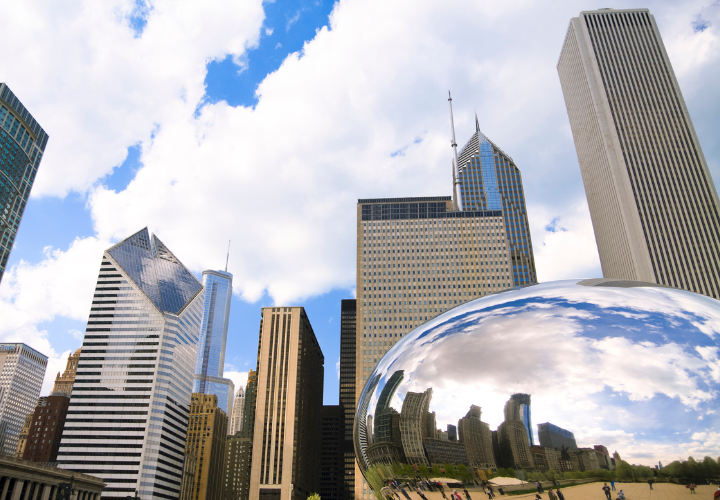On Sep. 21, 2022, Chicago City Council passed the 2022 Chicago Energy Transformation Code into law, an ambitious set of new construction regulations that aim to make the city more sustainable and eco-friendly.
Championed by Chicago Mayor Lori Lightfoot, the new code is part of a broader effort by the city to reduce greenhouse gas emissions and combat climate change through smart building methods and techniques.
The 2022 code went into effect for new building permits filed on or after Nov. 1, 2022 and additional requirements will take effect on Jan. 1, 2023. The 2022 code has introduced several new changes that could affect building projects across the city. Let's take a closer look at the new requirements to help Chicago builders better prepare to meet compliance.
Part of a larger urban sustainability strategy
The 2022 code updates are the latest effort by the city of Chicago to stay at the cutting edge of advancements in energy-efficient construction and development. According to a press release from the mayor's office, the city began adding eco-friendly construction requirements to municipal code regulations in 2001 and has been updating those requirements every three years in accordance with the International Energy Conservation Code (IECC).
The 2022 code is based on the recently published 2021 IECC. The latest iteration, however, goes far beyond the recommendations of the international guidelines. Moving beyond mere energy conservation, the Chicago code updates aim to equip buildings with the tools and capacity to combat climate change by proactively reducing green gas emissions and energy wastage.
Main changes introduced by the 2022 code
The 2022 code introduces several new construction and building requirements in line with the city's stated sustainability objectives. Some of the new regulations construction professionals should understand include:
Solar panel installation
The code requires that new commercial buildings at 60 feet or less be equipped with "solar-ready zones" to facilitate the installation of solar panels in the future. Solar-ready zones need to be free of all specified obstructions (including pipes and HVAC equipment) and the collateral dead load of the roof must be at least 5 pounds per square foot, according to the code text. Solar-ready zones must constitute a minimum of 40% of the roof's total surface area.
Insulation improvements
Open or improperly insulated balconies can lead to significant heat loss and energy inefficiency. To combat this problem, exterior balconies and parapets that interrupt a building's "thermal envelope" — or the application of insulation throughout a building's walls and roofs — are now required to have continuous insulation. The minimum thermal resistance value is required to be equal or greater than that of the nearest wall.
Energy-efficient plant-growing facilities
To maximize the sustainability benefits of at-home gardens and facilitate the expansion of urban greenspaces, the new code requires lighting used in plant-growing facilities to adhere to specific photosynthetic photon efficacy guidelines. For greenhouses, there is a requirement of at least 1.7 Joules per mole. A 2.2 Joules per mole requirement applies to all other indoor growing spaces.
There are some important exceptions to these provisions. For example, they do not apply to cannabis-growing facilities, which are subject to the city's separate Cannabis Regulation and Tax Act.
Gas-fired lighting prohibitions
The new code prohibits the installation of all new gas-fired lighting appliances, including lanterns, torches, as well as indoor and outdoor lamps powered by natural gas-burning technology, according to the Chicago municipal government. While gas lighting is often considered more economical and easier for consumers to manage, it is inefficient and wasteful, especially at scale.
Facilitating future electrification
While nonlighting gas-powered appliances are still permitted, new residences have to be constructed in a way that facilitates future appliance electrification. For example, clothes dryers must be equipped with an individual branch circuit that has a minimum rating of 30 amperes and 240 volts, according to the code text. Similar requirements apply to other appliances.
The 2022 code's broader objectives
The 2022 code is part of a larger, concerted effort by the city of Chicago to combat climate change. Its broader sustainability objectives were detailed in its 2022 Climate Action Plan, which committed the city to reducing its carbon footprint by 62% by 2040. The ultimate objective is to create a more livable city for all of Chicago's residents, especially historically marginalized groups.
The 2022 code will contribute to that wider vision. According to figures released by the mayor's office, the sustainability initiatives contained in the 2022 code will increase energy efficiency for residential and commercial buildings by 40%.
Changes are coming to Chicago's energy code, and construction professionals need to be prepared. Reach out to the team at Milrose Consultants for help navigating the recent code updates.







